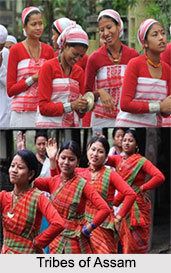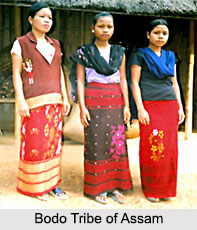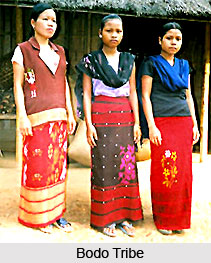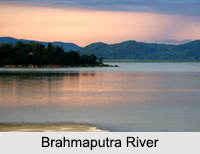Introduction
 Tribes of Assam are the aborigines of the land who have inhabited the area for ages. They are often recognised as the first inhabitants of the land who belong to various tribal groups. Major tribes of Assam earn their livelihood through agriculture and by selling their handicrafts.
Tribes of Assam are the aborigines of the land who have inhabited the area for ages. They are often recognised as the first inhabitants of the land who belong to various tribal groups. Major tribes of Assam earn their livelihood through agriculture and by selling their handicrafts.
Different Tribes of Assam : Assam is largely populated by the Tibeto-Burmese tribal race that forms the Bodo tribe and Mishing tribe. The tribes of Assam include a number of tribes namely; Chakma, Dimasa, Garo, Hajong, Hmar, Khasi, Jaintia, Khamti tribes, some Kuki tribes, Lakher, Barmans in Cachar, Deori, Hojai, Kachari, Sonwal, Lalung, Mech, Rabha who form the core of Tribal community of Assam.
Deori Tribes
Deori tribe is a major part of tribal community of Assam. They are settled in the districts of Dibrugarh, Tinsukia, Sibsagar and Lakhimpur.
Kachari Tribe
They are considered to have reached the Brahmaputra valley via Tibet or southern China and settled in the foothills of the eastern Himalayan range which includes the whole of Assam, Tripura, North Bengal and parts of Bangladesh.
Karbi Tribes
Karbi tribes are found in the hilly areas of Assam. Their domain is Karbi Anglong district. Some are also found in North Cachar Hills District, Nagaon, Golaghat, Kamrup, Jorhat, Sonitpur and Lakhimpur districts of Assam. This community initially settled in the Khasi and Jaintia hills from where they slowly migrated to other areas.
Mishing Tribes
Mishing tribes are also called "Miri" by the local people. They are supposed to be a branch of Adi tribes of Arunachal Pradesh, who came down to Assam as a result of inter-tribal feuds. They are mainly concentrated in Tinsukia, Dibrugarh, Sibsagar, Jorhat, Golaghat, Darrang, Sonitpur, North-Lakhimpur and Dhemagi.
Dimasa Tribes
Dimasa tribes are another group of tribal community found in Assam which represents an example of Patri-matrilineal tribe. They are mostly found in the North Cachar district and Karbi along districts of Assam.
Bodo Tribes
The Bodo tribes are supposed to be the earliest tribes of the land. They are scattered in all parts of Assam and are largely found as the workers in the tea plantation. As the Bodos are the oldest tribal group, they bear distinct cultural trends which mark them separately.
Phake Tribes
Phake tribes reside in Dibrugarh and Tinsukia district of Assam, along Dihing River. Phake tribe are said to have come here from Thailand in the late 18th century and speak Assamese language as well as Phake language.
Rabha Tribes
One of the Scheduled Tribes in the districts of Assam, the Rabhas are widely scattered but mostly concentrated on Goalpara, Kamrup and Darrang. The Rabhas believe in "evil spirits" and perform special pujas to appease the demons.
Tribal Unrest in Assam
 Tribal unrest is a prominent part of the political culture of the state of Assam. One group of tribes, concentrated in the remaining hill areas of the state in the Karbi Anglong district and North Kachar Hills district, demanded the creation of a self- governing unit within Assam. The second, a much larger group of tribes within which the largest are known as Bodos, are plains tribals living in the heartland of Assam by and large on the northern bank of the Brahmaputra River, but with some on the southern bank as well.
Tribal unrest is a prominent part of the political culture of the state of Assam. One group of tribes, concentrated in the remaining hill areas of the state in the Karbi Anglong district and North Kachar Hills district, demanded the creation of a self- governing unit within Assam. The second, a much larger group of tribes within which the largest are known as Bodos, are plains tribals living in the heartland of Assam by and large on the northern bank of the Brahmaputra River, but with some on the southern bank as well.
Like other tribal peoples in another place in the northeast and in other parts of India, Bodo leaders complained that they had lost lands to non tribal peoples, that they were educationally backward, and that their language was not taught in schools to their own children. Language issues are inseparably connected to the question of jobs. Nearly all Bodos know and use Assamese in their every day lives, but the few Bodos who do receive secondary or higher education face hard competition for public sector jobs, from the dominant Assamese Hindu castes, who have also benefited in their competition with Bengalis by the establishment of Assamese as the one and only official language of the state. The natural step for the Bodos in this state of affairs, as a result, is to demand acknowledgment for their language and the creation of a separate state in which their language and culture would be recognised.
Since the Bodos are plains tribals, they suffered also from the impact of migrations and encroachments on lands in the Brahmaputra valley and as a result participated actively in the anti migrant movement led by the AASU. An All-Bodo Students` Union (ABSU) was created to demand the establishment of a separate state of Bodo land. On January 1, 1987, ABSU presented a memorandum containing a long list of demands, which it followed with a demonstration in March, 1987. The most important demands were for the establishment of a separate Bodo state on the north bank of the Brahmaputra River, comprising nearly half the remaining area of the state of Assam and the creation of autonomous district councils for the Bodos.
 After the failure of a long succession of agitations on behalf of their demands, the Bodo movement turned more and more to purposeful violence in 1988 and 1989. Bodos have felt displaced as well by "non-tribal Assamese" in the area, by Hindu settlers from outside the area, and by Nepalis. Aggression reached a peak in August, 1989 when Bodo activists attacked and burned the villages of non Bodos and Assamese Hindu and non tribal groups massed and responded with similar attacks against Bodo villages. In the consequences of the massacre, an agreement was reached among the ABSU leader, the chief minister, and a minister from the central government on August 28, 1989 in New Delhi under which the Bodo militants would stop the violence while the state government would remove emergency legislation previously introduced giving it exceptional powers to deal with the insurgency, but the agreements did not hold.
After the failure of a long succession of agitations on behalf of their demands, the Bodo movement turned more and more to purposeful violence in 1988 and 1989. Bodos have felt displaced as well by "non-tribal Assamese" in the area, by Hindu settlers from outside the area, and by Nepalis. Aggression reached a peak in August, 1989 when Bodo activists attacked and burned the villages of non Bodos and Assamese Hindu and non tribal groups massed and responded with similar attacks against Bodo villages. In the consequences of the massacre, an agreement was reached among the ABSU leader, the chief minister, and a minister from the central government on August 28, 1989 in New Delhi under which the Bodo militants would stop the violence while the state government would remove emergency legislation previously introduced giving it exceptional powers to deal with the insurgency, but the agreements did not hold.
Successful measures to restrain the rebellion and arrive at a lasting political solution were handicapped by the fact that the parties in control of the state and central governments, the AGP and the Congress, respectively, were antagonistic. The continuance of the Bodo agitation served Congress purposes to the level that it discredited and weakened the AGP government in the state. The ABSU gave birth to its own political party, the Bodo People`s Action Committee (BPAC), which won all eight seats to the Assam Legislative Assembly and the one Lok Sabha seat as well in the 1991 elections from the areas inhabited principally by Bodos. A major obstruction to the achievement of the Bodo demand for a separate state is that the Bodos are not in fact in a majority in the area which they declare for their own. They share the area not only with migrants, but with other non Bodo tribal peoples. Eventually, in negotiations with the state and central governments, Bodo leaders agreed to accept the award of a Bodo Autonomous Council within the state of Assam.





















